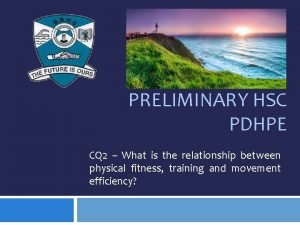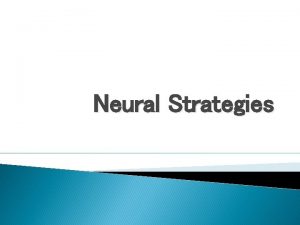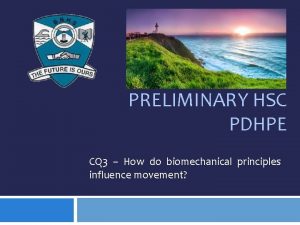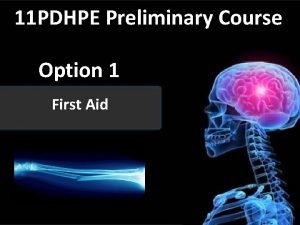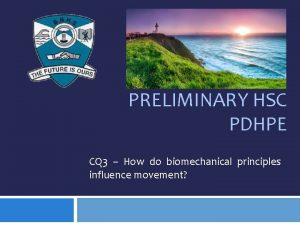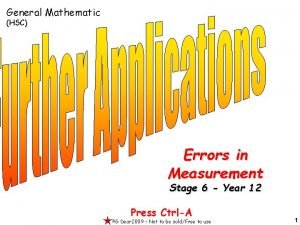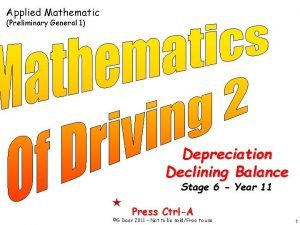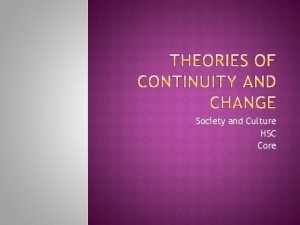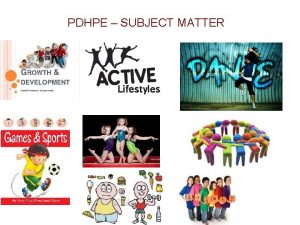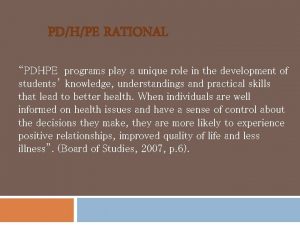HSC PDHPE CQ 4 DP 2 CQ 4































- Slides: 31

HSC PDHPE – CQ 4 DP 2 CQ 4 – How does the acquisition of skill affect performance?

How does the acquisition of skill affect performance? Students learn about: characteristics of the learner, eg personality, heredity, confidence, prior experience, ability Students learn to: describe how the characteristics of the learner can influence skill acquisition and the performance of skills

2. characteristics of the learner, eg. personality, heredity, confidence, prior experience, ability Each human has unique physical, social and emotional characteristics. The ways in which people learn, perform and think affect every aspect of their lives. These individual differences include inherited, social and emotional factors and they account for the variability in the learning of motor skills. Inherited factors affecting skill acquisition include gender, age, race, somatotype (body shape), muscle-fibre composition, information-processing capacity and aptitude for the activity. These can be described as the natural ability of the athlete.

2. characteristics of the learner, eg. personality, heredity, confidence, prior experience, ability After training and practice an athlete’s ability to perform activities is usually improved. Prior experience with the task (or with a similar task) will also affect performance.

Ø Personality

Ø Personality By understanding an athlete’s innate personality, a coach is more able to assist them in their skill acquisition. When choosing athletes to join a team or squad, coaches will choose those who they feel they can work with, and who will fit seamlessly into the team. An understanding of personality types will assist in their decisions, as a combination of personality types in a team is generally beneficial.

Ø Personality There are many studies that delve into personality types, but we will look into one particular scheme that suggests there are four broad types of personalities. These can be described as the driver, expressive, amiable and analytical personality types (although there are many other versions of this scheme).

Ø Personality ü ü Some of the characteristics of each personality type. Driver (often referred to as an eagle): Driver personalities know what they want and how to get it. They are driven, they get to the point, they are brash and tactless, they have high energy and they do not shy away from conflict. They like to be considered as leaders. Expressive (often referred to as a peacock): These people are enthusiastic, and are good motivators and communicators. They can tell a good story and therefore exaggerate or leave out important details. Sometimes they are known to talk about doing things, rather than actually doing them.

Ø Personality ü ü Amiable (often referred to as a dove): Amiable types are very kind and sympathetic people who avoid conflict. They have difficulty making decisions and can appear wishy-washy or spineless. They are very sensitive and very quiet. Analytical (often referred to as an owl): These are very detailoriented people. They must have all the facts and can be overly critical and pessimistic. They are also very perceptive.

Ø Personality No one type of personality is better than the others—each type has its pros and cons. But the more we understand about how personalities work and what motivates people, the better chance we have of acquiring skills ourselves, and of helping others acquire those skills too. We must also realise that we can not rely on the four personality types alone. Independent of each of these categories is the individual athletes’ desire, determination, enthusiasm, dedication and work ethic.

Ø Heredity

Ø Heredity refers to those genetic characteristics we inherit from our parents. We are all born with certain features and traits that make us more suited to some types of activities than others. These are factors we cannot change, no matter how hard we try. Our bone structure and our physical attributes cannot be altered easily. By using the knowledge we have of our genetic make-up, we can better decide on the sports or skills to pursue.

Ø Heredity Even though heredity plays a large part in our success, it will not limit our ability to learn a new skill. It will, however, limit the degree of success we can achieve. For example, a small and thin young boy will learn the skills to play rugby league, but he may never develop the quality of the skill to be selected in the high grades.

Ø Heredity (Somatotype) The following are just some of the genetic factors that can affect athletic success. Body types and shapes Somatotype, or body type, is one hereditary factor worth considering when considering suitability for certain sports: ü Ectomorph. This body type is generally tall, thin and lightly muscled, and is suited to sports such as basketball and volleyball. ü Mesomorph. This body type is hard and muscular, and is common among gymnasts and weightlifters. ü Endomorph. This body type is generally soft and pear-shaped, with underdeveloped muscles and excess body fat on the body, arms and thighs.

Ø Heredity (Somatotype)

Ø Heredity Differences in height and body mass can also give an individual physical and biomechanical advantages that would make them more suited to some sports or skills over others. Different muscle fibre types have also been shown to effect an athlete’s performance. Those individuals with slow twitch fibres are more suited to endurance sports like running, swimming and cycling. Those with fast twitch fibres show suitability to short-duration, high-intensity sports such as soccer and short to middle-distance running.

Ø Heredity Gender differences have been debated for decades. In today’s society, women work side-by-side with men in all occupations, from emergency services to armed forces. Competitive sport, however, still separates men from women. Higher levels of testosterone in male athletes can give them an advantage in building strength and power through muscle development. The ability to visualise the skill being performed correctly in the mind also plays a significant part in the effective learning of a new skill.

Ø Confidence

Ø Confidence For any individual learning a new skill, having confidence in their own ability is extremely important. Some level of confidence will be internally generated, based on how a learner or athlete sees themselves. (This refers back to the personality types. ) But a significant amount of confidence will be built up or destroyed based on their level of success in acquiring the new skill.

Ø Confidence It is critical that a coach or teacher provides constructive criticism accompanied by positive feedback to assist the athlete in feeling good about the process. The athlete must remember that mistakes are a part of learning and that we all progress at different rates. This will mean they have a better chance of keeping their confidence levels high.

Ø Prior experience

Ø Prior experience Have you ever picked up a new skill much more quickly than you expected? If so, you may have experienced a transfer of learning, in which a skill you learned in one situation has helped you to learn a different (but related) skill. For example, learning how to hit a ball with a cricket bat will be easier for someone who already has the skill of hitting a ball with a baseball bat. Even though the two skills are very different, they have some similarities. The hand–eye coordination needed to connect a bat with a ball provides some level of already acquired skill.

Ø Ability

Ø Ability We often hear the term ‘She (or he) is a natural!’ This means that a person is talented or gifted, or appears to have an inherent ability (trait). An athlete who shows ability shows ease and precision in executing a skill or task. ‘Abilities’ represents a culmination of all the factors described previously. They underpin many skill performances, and assist an athlete to grasp a new skill with ease, moving through the stages of skill acquisition quickly and effortlessly. Examples of abilities include coordination and perception.

Ø Learning preferences

Ø Learning preferences Everyone has a preferred learning style, whether it is through our visual, verbal, kinaesthetic (movement) or auditory (hearing) perceptions. If coaches know the learning preferences of their athletes, they can adapt their coaching methods to suit their athletes’ needs whenever possible.

Ø Questions to complete Explain the differences you would see in an individual as he or she moves through the three stages of skill acquisition in the sport of golf. Missing the ball, poor stance

Ø Questions to complete Identify pairs of sports (such as hockey and cricket) that show prior experience can lead to a transfer of skills and improve how quickly the sport is learnt.

Ø Questions to complete Explain how natural ability assists somebody to perform an activity well.

Ø Questions to complete Outline the role that personality plays in determining athletic ability and learning.

Ø Questions to complete Identify the characteristics of a learner that would have the greatest effect on: a increasing performance b decreasing performance.
 Hsc pdhpe
Hsc pdhpe Recovery strategies
Recovery strategies Physiological adaptations pdhpe
Physiological adaptations pdhpe Graduated exercise pdhpe
Graduated exercise pdhpe Kinaesthetic sense pdhpe
Kinaesthetic sense pdhpe Pdhpe core 1 practice questions
Pdhpe core 1 practice questions Centre of gravity pdhpe
Centre of gravity pdhpe What is situational analysis in first aid
What is situational analysis in first aid Skill test in totaps is necessary when
Skill test in totaps is necessary when What is the ottawa charter pdhpe
What is the ottawa charter pdhpe Fluid mechanics pdhpe
Fluid mechanics pdhpe Risk behaviours definition pdhpe
Risk behaviours definition pdhpe Hydraulic training pdhpe
Hydraulic training pdhpe Fluid intake pdhpe
Fluid intake pdhpe Fitt principle for volleyball
Fitt principle for volleyball Minimum standards test practice
Minimum standards test practice Hsc pension calculator
Hsc pension calculator Percentage error hsc
Percentage error hsc Hsc hub
Hsc hub Hsc 3047
Hsc 3047 My pension hscni
My pension hscni Gap filling without clues for ssc
Gap filling without clues for ssc Streetscapes of pompeii and herculaneum
Streetscapes of pompeii and herculaneum Exurbanisation definition
Exurbanisation definition Business report hsc example
Business report hsc example Enquiry letter about tour
Enquiry letter about tour Hsc pension service
Hsc pension service Declining balance method formula hsc
Declining balance method formula hsc Temple hsc library
Temple hsc library Hsc multiple choice generator
Hsc multiple choice generator Hsc pensions calculator
Hsc pensions calculator Hsc society and culture
Hsc society and culture
